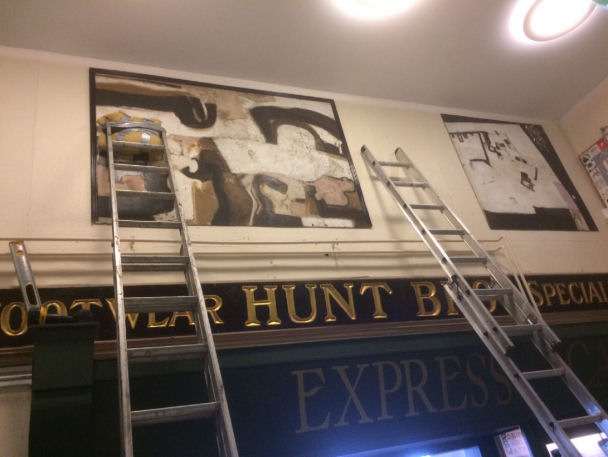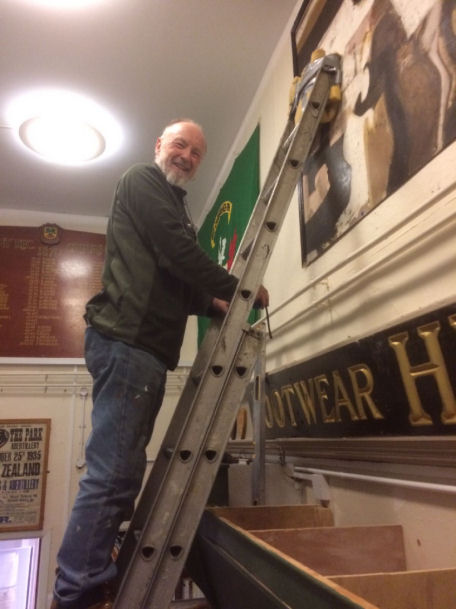Dates for your Diary
Ongoing – WW1 Exhibition in the Museum
Saturday 19th May – Coffee Morning - Hobbies and Crafts
Saturday 16th June – Coffee Morning - Aberbeeg Hospital
Monday 18th June – Food Hygiene Course (see page 3 for details)
Saturday 21st July – Coffee Morning - School Days
April 100 Club
No. 11 Vera Smith £20
No. 04 Dale Challenger £10
If you would like to join our 100 club and be in with a chance of winning, it costs just £1 a month. Ask at the museum for further details.
Paintings by Roger Cecil


Thanks to a grant from the Welsh Church Fund (administered by Blaenau Gwent CBC), the museum now proudly displays work by Abertillery artist Roger Cecil. Local carpenter Martin Hoare has done an excellent job of framing and hanging the paintings, two of which are right over the Express café where they can be viewed at leisure over a nice cup of coffee. Do pop in and take a look!
Coffee Morning
We had a good turnout for our coffee morning on Saturday 14th April. The theme was Navy Day and the talk was due to be given by our curator Don Bearcroft. Unfortunately, Don has been very unwell of late and was unable to attend so Margaret Cook very kindly stood in for him and very thankful we are to her. The talk was followed by a short quiz, with a Navy theme of course, delivered by volunteer helper, Sharon Saunders. Our next coffee morning is on 19th May, 10-1pm, with a look at hobbies & crafts, both past and present.
Annual Luncheon
Our annual luncheon on 16th April was very well attended and a lovely opportunity to meet fellow members including our new President, Mr Jack Hanbury who was most charming and spoke very eloquently despite having nothing prepared in advance. Thank you Mr Hanbury and we look forward to seeing more of you in the future.
Bishop’s Palace, Mathern

Why is there a Bishop’s Palace in the small hamlet of Mathern on the Gwent Levels near Chepstow? It all goes back to the story of Tewdrig, who was the King of Gwent and the adjoining area of Glwysing in post-Roman times.
Tewdrig is believed to have lived between 580 and 630 and to have abdicated at some stage in order to live the life of a hermit near Tintern, his son Meurig taking over the role of king. Tewdrig had been a noted warrior who fought, with Meurig, in many battles and when faced with the threat of a Saxon invasion in 630, Tewdrig was persuaded to join his son in battle once more.
Tewdrig, a Christian, saw the battle as also a religious one, the Saxons being regarded as pagans who had effected the destruction of a number of monasteries. He was seriously wounded in the battle and was to be taken to the island of Flat Holm where he wished to be buried. The ox-cart on which he was being carried stopped near a spring – now known as St Tewdig’s Well – and the waters from it were used to cleanse his wounds. Tewdrig died at the site of the spring and his son built a great church on the spot – now the site of the parish church of St Tewdric. His father’s body was enshrined there and the place became known as Merthyr-Teyryn (Mathern) or ‘Martyred Prince’. Meurig is said to have given lands at and around Mathern to the Bishops of Llandaff, in memory of his father.
 It is thought that the subsequent decision to build a bishop’s palace there was due to the proximity of a well-used crossing point of the Severn Estuary and proximity also to the protection (from attacks by the Welsh) afforded by the castles of Caldicot and Chepstow. The palace was the main residence of the Bishops of Llandaff between about 1400 and 1700. The buildings are listed and include a 15th century stone tower and a 16th century chapel. The building complex fell into ruin and was restored at the end of the 19th century. It is now privately owned and offers overnight accommodation and rooms to hire for events.
It is thought that the subsequent decision to build a bishop’s palace there was due to the proximity of a well-used crossing point of the Severn Estuary and proximity also to the protection (from attacks by the Welsh) afforded by the castles of Caldicot and Chepstow. The palace was the main residence of the Bishops of Llandaff between about 1400 and 1700. The buildings are listed and include a 15th century stone tower and a 16th century chapel. The building complex fell into ruin and was restored at the end of the 19th century. It is now privately owned and offers overnight accommodation and rooms to hire for events.
If you visit the Old Railway Station at Tintern, now a visitor attraction, you will find a circle of six large wooden sculptures – the Circle of Legends, one of which is of Tewdrig.
Jen Price
Express café
The museum has recently invested in a small freezer which now means we are able to offer more in the way of snacks alongside our hot and cold drinks. We now offer ice creams and ice-lollies (here’s hoping for a warm summer) as well as toasted fruit loaf and scones with jam and butter. We are still very competitively priced so do pop in and take a look at our new menu and if any of you have any suggestions of things you would like to see on our menu please let us know.
The expansion of our menu means also that we need to put our café on a more professional footing and to that end we are planning on running a Food Hygiene Course for our volunteers. We have space on the course for other interested parties too, please see page three for more details.
Volunteers wanted
Following a notice on Facebook about our high running costs forcing us to reduce opening times, the museum has had a sharp rise in visitor numbers! For the first time ever we opened on Good Friday and Easter Tuesday and had over 50 children plus their parents taking part in our Easter Egg Hunt, most of whom then visited our café and gift shop. We have also had a number of new members join the museum, a new Vice President, Major David Wise of the Salvation Army, plus a swell in the number of people joining our 100 Club which is all good news for the museum (many thanks to you all). If this new trend continues (and we sincerely hope it does) then we desperately need more volunteers to help around the museum, from serving in the shop and café to documenting donated items. If you can spare a few hours a week to help we would be most grateful.
Sally Murphy
Heritage Walk
Frank Olding, Curatorial Advisor to the museum and Heritage Officer with BGCBC is leading a 3 mile heritage walk on Wed 9th May to Chartists’ Cave. Meet at 2pm at Top House Pub, Trefil NP22 4HG, cost £3. To book ring 07971 081647 or email frank.olding@blaenau-gwent.gov.uk. An afternoon ramble to the Cave and a look at some upland archaeology.
The NHS is 50
The National Health Service will be 50 years old this year. It was launched on July 5th 1948 by the then Labour Health Secretary, Aneurin Bevan at Park Hospital in Manchester (now known as Trafford General Hospital). Aneurin Bevan was to become known as the ‘father’ of the NHS. It was a very ambitious plan to make good healthcare available to all, free at the point of delivery. For the first time doctors, hospitals, dentists, opticians and pharmacists were all brought together under one umbrella to provide a free service, funded entirely from taxation.
I remember my late father telling me that there was an immediate rush on the service, suddenly everyone was wanting free spectacles and dental work in particular and the service was put under immense pressure from the word go. A few years ago I was talking to an old friend of my late father, who herself is also now deceased, and she told me that in 1950, her dentist recommended she had all her teeth removed and replaced by dentures. Being young and naïve, she took his advice, something she came to bitterly regret and so at the tender age of 18, she had a full set of false teeth! From this I can only conclude that some medical professionals also took advantage of the fees they were being paid by the government to provide the service and were encouraging people to have unnecessary work done.
Under this sort of pressure, plans were put forward in 1951 by the Attlee (Labour) Government to introduce prescription charges. This caused a string of resignations including that of Aneurin Bevan and the future Prime Minister, Harold Wilson. In 1952, under a Conservative Government, a prescription charge of one shilling (5p) per form was introduced along with a £1 flat rate for ordinary dental work.
By 1956 the NHS drugs bill had risen to £58 million and prescription charges were raised to one shilling per item. Three years later in 1959, prescription charges were increased to two shillings per item. Then, in 1965, prescription charges were abolished by a Labour government under Harold Wilson.
However this caused the NHS drugs bill to soar as many low-cost drugs that the public had been buying for themselves, were now being increasingly prescribed. So, in 1968, Harold Wilson was forced to re-introduce prescription charges at the rate of two shillings and six pence per item but with a range of exemptions such as for the young, the elderly, those on benefits and those with some chronic conditions such as diabetes, though surprisingly having cancer did not give one an exemption! Currently prescription charges in England stand at £8.80 per item.
In 2001, the Liberal-Labour led Welsh Assembly voted to abolish prescription charges in Wales for the under 25’s. This was extended to all in 2007 and remains the same today. Though how long this can be sustained, remains to be seen.
Our NHS is not perfect by any means but, despite all its failings, I think it is safe to say that for those millions around the world who cannot afford health care, our NHS is still a thing to be envied.
Sally Murphy
Food Hygiene Course
We are running a level 2 Food Hygiene Course at the museum on Monday 18th June, 9.30 – 4.30. The course is a one day (6½ hour) accredited course and will lead to a qualification. We need a minimum of 8 learners but can take up to 14. The course will be free to museum members with just a small fee of £5 to non-members. As it is an all day event, the museum is happy to provide lunch for £2.50 a head (sandwich, crisps, hot drink etc) or learners can bring their own packed lunch. If you are interested or know of anyone who might be, please contact the museum during opening hours (Thursday – Saturday, 10-1pm) to book your place.
Please note photo id will be required on day of course (such as driving licence, passport or bus pass etc). If you have no photo id, there is a way around it, just mention this when signing up. If this course is a success, we may be able to run a variety of courses for the benefit of both our members and the wider community.
Thanks
Many thanks to the members of the Inner Wheel Club of Abertillery & Blaina for their generous donation of £50.
MUSEUM MATTERS
This month HMS Ocean has been in the news as this flagship of the Royal Navy has been sold to the Brazilian Navy. I found this upsetting because, as an ex Naval Cadet, I have seen this happen before and I am proud of our Royal Navy. HMS Ocean was our grandson Luke’s first ship which he joined after completing his basic training at HMS Raleigh and on which he served until he helped decommission it in March 2018.
When I was a Naval Cadet we went on a few exercises, one of these was an NATO exercise in the English Channel, the Flagship and Fleet Flagship was HMS Tiger. HMS Tiger was one of three conventional cruisers of the Royal Navy. She was a new design and was approved in 1951, but construction did not start until 1954. Her captain (Washbourn) said that HMS Tiger had been designed to cope with nuclear attacks, in that she could steam for up to a fortnight through radio-active fall-out with remotely controlled boiler, engine and armaments and by operating with re-circulating purified air below decks, could operate as a fighting unit even if a nuclear bomb were dropped nearby. It was said that their fire power, endurance, and self-sufficiency would make them very effective ships for a long period to come, and that this was especially true in areas east of Suez, where distances were so gigantic.
Decommissioning and Disposal
In 1978 Tiger was placed in reserve. She was decommissioned on 4 May 1979 and was put on the disposal list. Both Tiger and her sister-ship HMS Blake were listed as part of the Standby Squadron, and moored inactive at HMNB Chatham.
 When the Falklands War broke out in early April 1982, both ships were rapidly surveyed and it was determined that both were in very good material shape, and both were immediately drydocked (Tiger in Portsmouth and Blake at Chatham) and Destroyer recommissioning work was begun.
When the Falklands War broke out in early April 1982, both ships were rapidly surveyed and it was determined that both were in very good material shape, and both were immediately drydocked (Tiger in Portsmouth and Blake at Chatham) and Destroyer recommissioning work was begun.
Whilst there was speculation that their 6-inch guns would be useful for shore bombardment, the real reason for their potential deployment was the size of their flight decks (the third largest in the Royal Navy at that time) and the potential to use them as mobile forward operating and refuelling bases for Task Force Harriers.
HMS Blake had already operated RAF Harriers briefly for proving trials in 1971, and Harriers had refuelled on Tiger. Their benefit would be more as platforms to extend the range and endurance of the Sea Harriers as an extended-range CAP (Combat Air Patrol).
In May 1982, after the loss of the destroyer Sheffield and the Argentinean cruiser General Belgrano, the refits were stopped. Tiger existed until mid 1986, and following competitive tendering she was sold for scrap to Desguaces Varela of Spain. She was towed to Spain and scrapped in October 1986.
When Ian Smith, the prime minister of Rhodesia, and Harold Wilson held talks onboard HMS Tiger in December 1966, relating to Rhodesian independence from Britain, these later became known as the Tiger Talks!
The Latest Royal Naval Ship
The latest Royal Naval War Ship has a radar footprint the size of a fishing boat despite being 5,400 tons. Its Stealth Warship features include hangars that can hold speed boats, helicopters or drones. It is capable of sailing the world’s oceans carrying the helicopters and cruise missiles and its 185 crew virtually undetected by the enemy.
The Royal Navy’s Future
The type 26 global combat ship measures 148 metres from end to end and can be used for combat and relief work and is the stealthiest ever built by Britain. One of the new ideas of the navy is that instead of using mast head radar, it is to use radio controlled drones sending messages back to their ships.
Don Bearcroft, Curator

Top Of Page


